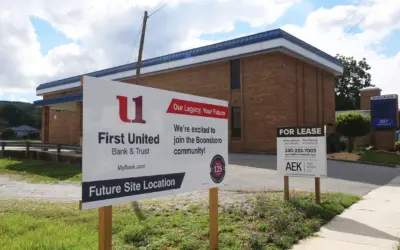Blog
Watch Out for Student Loan Scams
Scammers are stepping up their game, sending slick emails, making bold promises, and using official-looking logos to trick borrowers into handing over money and personal info.
Garrett County Businesses Warned of Rising Invoice Scams
The Garrett County Chamber of Commerce, in collaboration with the Garrett County State’s Attorney’s Office, has issued an important alert to local businesses regarding a surge in fraudulent invoice scams.
Coming Soon: First United Bank & Trust opens new branch in Boonsboro
First United Bank & Trust, a trusted financial leader for over 125 years, proudly announces the addition of its newest branch in Boonsboro, MD. This expansion marks a significant milestone in the bank’s commitment to serving the growing needs of the Boonsboro community.
Don’t Let Travel Scams Ruin Your Vacation
From fake travel sites to phishing emails that look like they’re from your favorite airline, fraudsters are getting creative.
First United Bank & Trust relocates to new WestRidge office
First United Bank & Trust is proud to announce the groundbreaking of a new office location in the Morgantown area. The Star City office will be relocating to the new WestRidge development, just off Interstate 79.
Donna Burns Joins First United as Deposit Services Relationship Manager
Keith Morgan, Managing Director of Commercial Services at First United Bank & Trust, is excited to welcome Donna Burns to the team as a Deposit Services Relationship Manager in the Morgantown area.
Samantha Ballard named Assistant Branch Manager in First United Suncrest Office
Brandy Fawley, Community Office Manager at First United Bank & Trust, is excited to announce Samantha Ballard as Assistant Branch Manager at Morgantown’s Suncrest Office.
A Legacy of Giving on the Green: First United Hosts 37th Annual Charity Golf Tournament
First United Bank & Trust proudly teed off its 37th Annual Charity Golf Tournament on Friday, July 11, 2025, at the scenic Oakland Golf Club. As the event’s organizer, First United has helped turn this tournament into a cherished community tradition. Over nearly four decades, the event has raised an impressive $700,000+ for Garrett County charities — proving that a great day on the course can also make a powerful impact.
First United promotes J.T. Bowling to Mortgage Relationship Manager
Scott Hostetler, Vice President and Director of Mortgage Services at First United Bank & Trust, is thrilled to announce the promotion of J.T. Bowling to Mortgage Relationship Manager, working in the Washington County Hagerstown Office.
Bulls & Bears Third Quarter 2025
Click here to read the latest Bulls & Bears newsletter from third Quarter 2025.
Can You Spot an Investment Scam? Here’s What You Need to Know
Investment scams, especially those involving cryptocurrency, are on the rise. In fact, the U.S. Department of Justice (DOJ) recently seized a staggering $225.3 million linked to alleged crypto investment scams. According to the DOJ, this is the largest cryptocurrency seizure in Secret Service history.
Smart Borrowing: Solutions for Managing Student Loan Debt
College is more than an education — it’s the start of a new chapter, full of possibilities. However, for many students, the cost of higher education is a major financial hurdle. First United Bank & Trust loans cover tuition, housing, books, and supplies, so students can focus on learning and shaping their future.
First United Bank & Trust celebrates 125 years of community, commitment, and growth
First United Bank & Trust proudly celebrates its 125th anniversary in 2025, marking a significant milestone in its journey from a small-town bank to a trusted financial partner across multiple states. Founded in 1900 as the First National Bank of Oakland, the institution has grown to include 22 branches and more than 300 associates — yet its heart remains rooted in community.
First United introduces exclusive Solutions at Work program to enhance workplace financial services
First United Bank & Trust is thrilled to announce an exclusive opportunity for businesses through its Solutions at Work program. Designed to provide seamless financial solutions for employers and employees alike, this program prioritizes convenience, while delivering valuable benefits tailored to workplace success.
The Value of Overdraft Services: A Financial Safety Net for Consumers
Managing personal finances can be unpredictable, and sometimes expenses exceed available funds. In those moments, overdraft services offered by financial institutions like First United Bank & Trust serve as a crucial safety net, helping consumers avoid the inconvenience and potential harm of declined payments.
First United Bank & Trust establishes fund and special loan offer, helps community after devastating flooding
First United Bank & Trust is proud to announce additional relief options to support communities affected by recent storms and flooding within Maryland and West Virginia.
First United welcomes Coty Thorne to Commercial Relationship Manager role
Tanner Russell, Director of Commercial Services at First United Bank & Trust, recently welcomed Coty Thorne to the bank as Commercial Relationship Manager.
Tylor Mayfield joins First United Bank & Trust as Commercial Relationship Manager
Tanner Russell, Director of Commercial Services at First United Bank & Trust, is excited to announce that Tylor Mayfield has joined the bank as Commercial Relationship Manager.
First United sponsors Union Rescue Mission of Western Maryland, Inc., in receiving $1M grant for Affordable Housing Program
First United Bank & Trust is proud to sponsor Union Rescue Mission of Western Maryland, Inc. in receiving a $1 million grant from the Federal Home Loan Bank of Atlanta as part of its 2024 Affordable Housing Program General Fund awards.
Job and remote work scams on the rise
Looking for a new job, especially if you’re currently unemployed, can be an arduous and frustrating task.
Bulls and Bears Second Quarter 2025
Click here to read the latest Bulls & Bears newsletter from Second Quarter 2025.
First United welcomes W. Tanner Russell to Director of Commercial Services role
Keith Morgan, Managing Director of Commercial Services at First United Bank & Trust, is proud to welcome W. Tanner Russell as Director of Commercial Services.
Travis Teal joins First United as Commercial Relationship Manager
Alan Mullendore, Managing Director of Commercial Services, at First United Bank & Trust, is excited to welcome Travis Teal as a Commercial Relationship Manager in the Frederick area.
Keith Morgan joins First United as Managing Director of Commercial Services
First United Bank & Trust is excited to welcome Keith Morgan as the Managing Director of Commercial Services to lead and develop the commercial banking division and deposit growth strategies in its North Central West Virginia and Southwestern Pennsylvania market area.
Cassandra Bradshaw and Susie Brantner receive CAFP designations
First United Bank & Trust is proud to announce that Cassandra Bradshaw and Susie Brantner recently passed the Certified Anti-Money Laundering and Fraud Professional exam and can now proudly display their CAFP designations.
Avoid becoming a money mule
You may think that you could never fall for a scam, but as criminals become more and more sophisticated, anyone is susceptible to becoming a money mule.
Cody Sustakoski promoted to Regional Market President
R.L. Fisher, Senior Vice President and Chief Revenue Officer at First United Bank & Trust, is excited to announce the promotion of Cody Sustakoski to the role of Regional Market President of the North Central West Virginia and Southwestern Pennsylvania areas.
First United Bank & Trust changes illustrate commitment to growing region
As part of our commitment to uncommon service and customized solutions, First United Bank & Trust is happy to announce some new and exciting changes happening in the North Central West Virginia region, with a significant promotion and new team members coming to the Morgantown market.
First United Bank & Trust introduces special offer exclusively for veterans and first responders
To honor the commitment and bravery of our local veterans and first responders, First United Bank & Trust has put together a unique banking suite of products, services, and financial education exclusively for these community heroes.
Money Management Tips for Business Leaders
A good money manager will be in the best position to thrive for an extended period of time. He or she will have financial resources readily available, so if problems arise, this professional can overcome such issues without delay.
How a Small Business Can Manage Risk
As a small business owner, you are well aware of how a sound financial plan, effective risk management and intelligent decisions can benefit your company. In today’s entrepreneurial climate, there are plenty of places for mistakes to pile up, and a lack of focus can cause little errors to turn into major headaches.
Mikolas Ruggiero Promoted to Assistant Information Security and Disaster Recovery Officer
Marissa Murphy, Information Security and Disaster Recovery Officer at First United Bank & Trust, is pleased to announce the promotion of Mikolas Ruggiero to Assistant Information Security and Disaster Recovery Officer.
Payroll Data
In today's digital world, protecting payroll data is more than just a best practice—it’s a necessity. Employee paystubs and financial records contain highly sensitive information, including Social Security numbers, addresses, and bank details. If not properly...
How To Price Products at a Small Business
Every company thrives because of great customers, but even dedicated followers could quickly turn away if products aren’t priced correctly.
Disability Insurance an Essential Financial Service
There are times when a sudden illness or accident will make it impossible for someone to do the everyday things that need to be done, let alone go to work, and during that time money would become a major concern.
How an Entrepreneur Can Find the Right Work-Life Balance
Every entrepreneur needs a little time to themselves. A perfect work-life balance is certainly a goal for everyone – across any industry – and that idea is possible with some creative steps and a little bit of ingenuity.
The Top 4 Tips for Better Business Presentations
Instead of being nervous and blowing the entire thing, there are several great tips for anyone faced with a public speaking dilemma.
Being Prepared for a Business Loan
Nowadays it can be a little tough to get a commercial loan and while good business banking practices can help make a company look good when it becomes time to apply, there are other tactics and solutions owners can take to boost the odds in their favor.
How Families Can Save Money on Necessary Household Expenses
Frugal habits can save you lots of money. One dollar at a time, you can build a financially secure future for your family.
Who Does Your Employee Work For?
Businesses often face significant challenges when it comes to accurately determining the capacity in which a worker is employed. While they may know that an individual is on payroll and performs specific tasks, the way this person is classified within a human...
4 Tips To Help Your Sales Staff
Not everyone is good at sales off the bat, but with some work, everyone can learn what it takes to sell sand to a desert.
Recovering From Disaster: An Opportunity To Grow
Having a continuity system in place for your small business should be essential to your financial plan, but not all companies pursue this strategy.
Businesses Should Do More To Protect Online Information
In today’s economy, many businesses rely heavily on the Internet in order to connect with customers, boost a financial plan and improve sales.
Steps To Enhance Personal and Business Banking
A small business owner should pay attention to both his or her personal – as well as the company’s – finances. Smart business banking is a critical step to entrepreneurial success, and without taking advantage of the numerous financial services provided, meeting every goal might be more challenging.
Cheating On Your Pocketbook
Lying by omission can be just as bad as telling an outright fib when it comes to balancing your checkbook with your spouse.
4 Habits of the Best Small Business Owners
If you’re not a good boss, chances are people won’t be with your company very long. In order to maintain consistency and morale amongst your staff, you will have to treat employees well and make sure you’re always displaying the habits of a good manager.
3 Tips To Improve Business Networking
Meeting new people and forming connections is one of the most important aspects of the business world. Without these relationships, it will be much harder for companies to thrive – and for employees to find fresh opportunities and improve their skills.
How To Destress Your Employees
Approximately 25 percent of American employees view work as their No. 1 stressor, so implementing methods to increase relaxation at work are crucial.
How To Forecast Revenue
The idea of predicting revenue can be a daunting one. After all, nothing is certain, and even conditions you’re fairly confident about can change unexpectedly.
The Positives of Efficient Communication
Every business needs effective communication to thrive, but it is shocking how few actually have it.


















































